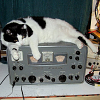this is two questions really, first, is a cap is a cap is a cap? If something calls for a cap of value X and I have several different types, lytic, polypro, or ? all with the same values, does it matter? Are certain types more suited to certain duties?
The other question, I was digging through my old stash of stuff and came across a handfull of surface mount caps, I have a half doz of each, they're black resin filled with a bunch of UL type stamps on one side, the values on top show them as .1uf 250v~x2 and .22uf 250v~x2 I've never seen a cap with the x2 after it and was worried that these might be "special" in some way. They are non polar or at least do not have anything on them to indicate that they should go one way or the other. I was thinking I might use them in something if they're just plain ole caps. If I remember correctly I pulled them from some computer boards of some kind back when I worked for Epson.
Any thoughts?
cap question
7 posts
• Page 1 of 1
cap question
it's not supposed to smoke when I turn it on is it?
-

hasafraker - Posts: 48
- Joined: Fri Apr 11, 2008 7:27 pm
- Location: Frickin Ohio
There are an endless variety of capacitor types ... too numerous to mention. For audio use, you are basically going to deal with electrolytics in the power supply and cathode bypasses, polypropylene foil and many variations for coupling caps, maybe a few ceramic disc for AC bypass duties (never in audio)
Boutique caps seem to be OK in coupling (driver to output) applications, I've used a few in my amps, not super expensive ones, but $ 8 or so each rather than the 69 cent jobs.
The caps you have with the x2 means there are two capacitors in one package ... take a look and see if there is one common ground, and two hot leads. Since the voltages are a little low for tube use, I can't think of an application for them.
Boutique caps seem to be OK in coupling (driver to output) applications, I've used a few in my amps, not super expensive ones, but $ 8 or so each rather than the 69 cent jobs.
The caps you have with the x2 means there are two capacitors in one package ... take a look and see if there is one common ground, and two hot leads. Since the voltages are a little low for tube use, I can't think of an application for them.
-

TomMcNally - Darling du Jour
- Posts: 2729
- Joined: Sat Nov 19, 2005 2:19 pm
- Location: Northfield, NJ
Thanks for the info Tom,
These little black caps have only 2 leads coming out of the bottoms, I did just notice a small round indent in the top corner of each but otherwise nothing remarkable about them, if there's really no application to this stuff I'll probably toss them since they're just takin up space Yellow_Light_Colorz_PDT_08
These little black caps have only 2 leads coming out of the bottoms, I did just notice a small round indent in the top corner of each but otherwise nothing remarkable about them, if there's really no application to this stuff I'll probably toss them since they're just takin up space Yellow_Light_Colorz_PDT_08
it's not supposed to smoke when I turn it on is it?
-

hasafraker - Posts: 48
- Joined: Fri Apr 11, 2008 7:27 pm
- Location: Frickin Ohio
Tom,
BAD LAD - giving such WRONG advise on an important issue!!!
Sorry - you pressed one of my buttons.
X2 is the SAFETY RATING CLASS - and specifies its suitabity for connection across the mains supply.
A quote from another site
"Class X caps are for across-the-line use. Class Y caps are for line-to-safety ground. These caps are constructed to be "self-clearing". That is, if the device develops a short, the energy dissipated in the short will "blow" the short away. A typical line input filter will have a single Class X cap from line to neutral or from line to line and a Class Y cap from each line to ground or from line to ground and neutral to ground."
It also relates to their flamability.
X1, X2, Y1, Y2 just have different voltage ratings.
I'm sure a web search would turn up exact info if interested. The X or Y Safety Class doesn't mean they have to be used for connection to mains supply, BUT it does tell you that they are suitable to be used for that purpose.
Cheers,
Ian
Edit:
Many (Not All) Class X2 Caps are metalised Polypropylene and make excellent audio coupling caps.
BAD LAD - giving such WRONG advise on an important issue!!!
Sorry - you pressed one of my buttons.
X2 is the SAFETY RATING CLASS - and specifies its suitabity for connection across the mains supply.
A quote from another site
"Class X caps are for across-the-line use. Class Y caps are for line-to-safety ground. These caps are constructed to be "self-clearing". That is, if the device develops a short, the energy dissipated in the short will "blow" the short away. A typical line input filter will have a single Class X cap from line to neutral or from line to line and a Class Y cap from each line to ground or from line to ground and neutral to ground."
It also relates to their flamability.
X1, X2, Y1, Y2 just have different voltage ratings.
I'm sure a web search would turn up exact info if interested. The X or Y Safety Class doesn't mean they have to be used for connection to mains supply, BUT it does tell you that they are suitable to be used for that purpose.
Cheers,
Ian
Edit:
Many (Not All) Class X2 Caps are metalised Polypropylene and make excellent audio coupling caps.
- Gingertube
- Posts: 245
- Joined: Thu Oct 05, 2006 10:27 pm
- Location: Adelaide, South Oz
More info - since its important
Class X1 - Suitable for use in 3 phase power lines (phase to phase). Impulse tested to 4,000 volts
Class X2 - suitable for use with line voltages up to 250V AC (active to neutral). Impulse tested to 2500V
Class Y1 - suitable for reinforced or double insulated equipment up to 250V AC. Impulse tested to 8000 volts.
Class Y2 - suitable for use with line voltages up to 250V AC (line to safety ground). Impulse tested to 5000 Volts.
There is also Class X3, Y3 and Y4 but these do not require any particular impulse test and are basically fairly meaningless.
Cheers,
Ian
Class X1 - Suitable for use in 3 phase power lines (phase to phase). Impulse tested to 4,000 volts
Class X2 - suitable for use with line voltages up to 250V AC (active to neutral). Impulse tested to 2500V
Class Y1 - suitable for reinforced or double insulated equipment up to 250V AC. Impulse tested to 8000 volts.
Class Y2 - suitable for use with line voltages up to 250V AC (line to safety ground). Impulse tested to 5000 Volts.
There is also Class X3, Y3 and Y4 but these do not require any particular impulse test and are basically fairly meaningless.
Cheers,
Ian
- Gingertube
- Posts: 245
- Joined: Thu Oct 05, 2006 10:27 pm
- Location: Adelaide, South Oz
oh, good stuff thanks for clearing that up, appreciate the info Ian Yellow_Light_Colorz_PDT_17
it's not supposed to smoke when I turn it on is it?
-

hasafraker - Posts: 48
- Joined: Fri Apr 11, 2008 7:27 pm
- Location: Frickin Ohio
Hi,
I've done testing with these. The polycaps are wound non-inductive and sound really good :)
High values can be had for free from discarded motorized appliances, like air conditioners, fridges, bread makers, etc.
The X2 ceramic caps make nice couplers in guitar amp circuitry as they have this non-linear curve that makes for an awesome tone, IMO.
Cheers!
I've done testing with these. The polycaps are wound non-inductive and sound really good :)
High values can be had for free from discarded motorized appliances, like air conditioners, fridges, bread makers, etc.
The X2 ceramic caps make nice couplers in guitar amp circuitry as they have this non-linear curve that makes for an awesome tone, IMO.
Cheers!
-= Gregg =-
Fine wine comes in glass bottles, not plastic sacks. Therefore the finer electrons are also found in glass bottles.
Fine wine comes in glass bottles, not plastic sacks. Therefore the finer electrons are also found in glass bottles.
-

Geek - KT88
- Posts: 3585
- Joined: Sun Oct 21, 2007 3:01 am
- Location: Chilliwack, British Columbia
7 posts
• Page 1 of 1
Who is online
Users browsing this forum: No registered users and 39 guests
